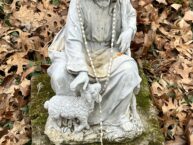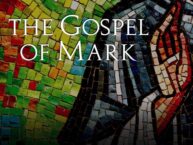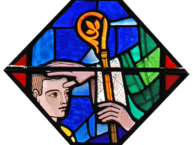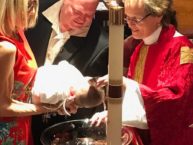May God’s words alone be spoken, may God’s words alone be heard. Amen.
So, the other day, a close friend of mine that I’ve know for nearly 30 years cracked me up…seems he was looking for his eyeglasses. “I couldn’t find them anywhere, he told me. I was in a hurry, trying to get out the door in the morning to catch the train to work, and frantically searching for my glasses…looking in the kitchen, the hallway, the bedroom, and finally – the bathroom…and do you know where they were – on my head! I lifted my head up and caught my reflection in the mirror and started to laugh so hard that, well, it was a good thing I was in the bathroom.” When he told me, I practically peed on myself too from laughing. And yet, I have to admit to having that sort of thing happen to me from time to time, and I am betting that one or two of you could tell a similar tale.
Why is it that sometimes we cannot see what is right in front of us? The travelers to Emmaus today were surprised that they didn’t see – really see – the person who had walked alongside of them on their journey out of Jerusalem.
This is a wonderful story, and one that many priests like to have read at ordinations and installations. One obvious reason is the link to what we experience in the Eucharist, but there is more. “What makes the story remarkable is how unremarkable it is. I can understand Jesus appearing to the remaining 11 disciples, to the faithful women who followed him, and even to Paul – all very practical appearances in terms of establishing the church and its mission. But, Cleopas and his companion are [unknowns…at least as far as scripture is concerned because we never hear of them before or after this narrative. And I think that is what makes this a great story, because “they could be any one of us. Their road to Emmaus is an ordinary road, the road each of us is on every day. This is what sets this story apart from other accounts of Jesus’ Easter appearances.
The whole narrative begins with two men who were walking from Jerusalem to Emmaus, when Jesus came along and began to walk with them. In an interesting twist, it is said that their “eyes were kept from recognizing him.” Now, hold on to that bit for a moment. As the story unfolds, Jesus asks them what they are discussing. And, it said that, “They stood still, looking sad.” They were astonished that this stranger didn’t know the big news story of the weekend. If we can’t imagine their feelings, think about someone walking up to two people in downtown Manhattan on September 14th 2001, and asking what was up – what were they buzzing about?
They tell him all about what has happened, and what the women said (that they still don’t believe). Then Jesus begins to interpret scripture for them. Now, if it ended there, it would still have been a great story, because remember that they said after they realized who it was with them that day, “Were not our hearts burning within us while he was talking to us on the road, while he was opening the scriptures to us?” But in a great twist, they invite Jesus to stay with them.
This invitation was customary for travelers, and was also part of the holiness code – to care for the stranger… something those who use our scriptures to beat up on others fail to remember. But these two – Cleopas and the other man, did the right thing – they invited this stranger to stay with them. And it changed their lives forever. Because in the breaking of the bread, their eyes were opened to see and experience Jesus in their midst. And then…he was gone!
On the surface, this is a fabulous story just on its own – one that I think resonates with so many of us, because we can understand what it must be like for those two, grieving the loss of their friend and of their faith in his being the Messiah. For many, the road to Emmaus is a metaphor for all those journeys in our lives that come out of grief or pain, but end in new life.
But how did they not see Jesus? I know it says “their eyes were kept from seeing him,” but what was that all about? I ask, because I think it is something that happens so very often to many people, even those who call themselves Christians.
The road to Emmaus is a spiritual journey that awaits all of us if we are able to see and experience the Jesus in our midst. But so often, we don’t seem to be able to do that. We are as lost as my friend looking for his glasses. Why is that? Are we too busy? Too distracted?
“Douglas Adams in his [fun little crazy book] “Hitchhiker’s Guide to the Galaxy” creates a space vehicle that is cloaked. It achieves this amazing state of invisibility because it is powered by [SEP] “Somebody Else’s Problem[…]” People bump into it without even noticing it is there.
“An SEP is something we can’t see, or don’t see, or our brain doesn’t let us see, because we think that it’s somebody else’s problem. … The brain just edits it out; it’s like a blind spot. If you look at it directly, you won’t see it unless you know precisely what it is. Your only hope is to catch it by surprise out of the corner of your eye ….“This is because it relies on people’s natural predisposition not to see anything they don’t want to, weren’t expecting or can’t explain.”
I love Adam’s concept of SEP. And I think our spiritual blindness can very much also be the result of what it was for Cleopas and his companion. We can be so distraught, so caught up in our concerns, our own worlds, and often those things are so numerous we can’t see beyond them.
There have been many studies on this phenomenon. In fact, there is a famous experiment about this very thing. “The phrase, “the invisible gorilla,” comes from an experiment created 10 years ago to test selective attention. In it, study participants are asked to watch a video in which two teams, one in black shirts and one in white shirts, are passing a ball. The participants are told to count how many times the players in white shirts pass the ball. Mid-way through the video, a[n actor in a] gorilla [suit] walks through the game, stands in the middle, pounds his chest, then exits. Then, study participants are asked, “did you see the gorilla?” More than half the time, subjects miss the gorilla entirely. More than that, even after the participants are told about the gorilla, they’re certain they couldn’t have missed it.”
So I think we can all understand the possibility of not seeing what is right in front of our eyes, or in my friends case – right on their face. We can understand what happened to Cleopas and his friend that day.
But taking a look at the story from another perspective, we find that it is actually the narrative of our lives in worship. “Think about the four-part movement of the narrative: 1) the two travelers are met on the road, 2) have the scriptures opened, 3) share in a meal that reveals the identity and presence of Christ, 4) and then are sent to share and live the good news. That strikes me as remarkably parallel to the classic Christian pattern of worship involving gathering, word, meal, and sending.”
We experience that here, right? We gather together in this sacred space, and we experience two parts of our worship. If you ever noticed, we have essentially two main parts of the service: The Word of God and The Great Thanksgiving (or Holy Communion). Both of these are equal in importance, which is why we put the gospel book front and center on the altar at the beginning of the worship service, often processing it into the church. When it is time for the Eucharist, it is moved and the vested chalice and paten become the center of attention on the altar.
And all of this brings to mind this – that our liturgy is our theology in motion. So much detail goes into planning what is not only heard, but seen. Often, we will ascribe meaning where there is none, like the altar rails [explain] or the washing of the hands [explain]. But there are other elements, like the order of the service, and how we move through it, that are a way for us to journey on that road to Emmaus.
We hear the Word of God, and then we experience the Word of God – the Logos – the Living Word – the Christ in the breaking of the bread, just as Cleopas and his companion did that very night. The scriptures were opened to them, and then, in the breaking of the bread, they experienced Christ.
That is the journey to Emmaus.
[A} story resonates with a sense of the church and its mission and of the tremendous power of the word and the sacraments to connect us with the presence of God. But, [more than that], its image is of God […] that walk[s] alongside human confusion, human pain and a human loss of faith and hope. Emmaus invites us to expect God to find us. Emmaus challenges us to see that it isn’t our unshakable faith and deep spirituality that connect us with the risen Christ, but our smallest gestures of hospitality and friendship.” That is the road to Emmaus!
But the road to Emmaus is only part of the story!
If we stop there – the church stops there – the Good News stops there.
It is the road to Jerusalem that completes the journey!
Here Luke tells us a story about two people that is really a story that makes a promise to those reading the gospel then and now: in Christian worship you will be encountered by the risen Christ.”…and then you must do something with that Good News!
Christ is alive – and will meet us in our pain, in our spiritual questioning. Everywhere we look, Christ will be – most especially in the stranger, the homeless, the poor, the marginalized, and the lonely. And if we living what we believe, they will see Christ in each of us!
So in this Eastertide, let us walk our journey to Emmaus by opening our hearts to the scriptures, opening our eyes to the Christ present with us in the breaking of the bread, and then share that Good News – that Christ is risen to the rest of the world.
Amen.
[Please note: All sermons are as written, not necessarily as delivered on that Sunday]
The Rev. Diana Wilcox
Christ Church in Bloomfield & Glen Ridge
May 4, 2014
Third Sunday of Easter – Year A
1st Reading – Acts 2:14a,36-41
Psalm 116:1-3, 10-17
2nd Reading – 1 Peter 1:17-23
Gospel – Luke 24:13-35






